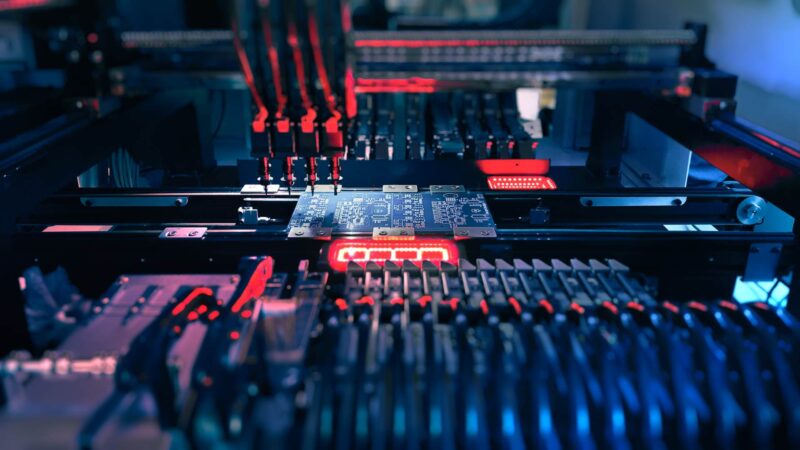Vision Inspection Systems: Revolutionizing Quality Control in the Pharmaceutical Industry
In the pharmaceutical sector, steadfast adherence to stringent quality control standards stands as the cornerstone of ensuring the safety and efficacy of medicinal products. With regulatory requirements evolving to new heights, industry leaders are increasingly embracing cutting-edge solutions, notably vision inspection systems, to fortify these standards. Positioned at the forefront of quality assurance, these systems are instrumental in meticulously detecting defects, meticulously validating labeling accuracy, and meticulously ensuring batch traceability. It is through these mechanisms that product integrity is vigilantly preserved, casting a protective shield over every stage of the manufacturing journey.
Market Size and Opportunities for Vision Inspection Systems in the Pharmaceutical Industry
Market Size:
The market for vision inspection systems within the broader inspection machines market is projected to witness steady growth in the coming years. Here’s a glimpse of the market landscape:
- Global Inspection Machines Market: Estimated at USD 841 million in 2022, the market is expected to reach USD 1.45 billion by 2032, growing at a CAGR of 5.8% [Source: Gminsights].
- Vision Inspection System for the Pharmaceutical Market: While specific figures for the pharmaceutical segment are scarce, it’s evident that this niche market is embedded within the broader inspection machine market and is expected to grow alongside it, driven by specific factors within the pharmaceutical industry.
Opportunities:
Several factors are creating lucrative opportunities for vision inspection systems in the pharmaceutical industry:
- Growing Regulatory Stringency: Stringent regulations from bodies like the FDA and EMA for Good Manufacturing Practices (GMP) are driving the need for robust quality control measures, making vision systems increasingly attractive.
- Rising Product Recalls: The increasing frequency of product recalls due to quality issues underscores the need for enhanced quality control solutions, making vision systems a valuable asset.
- Focus on Patient Safety: As patient safety remains paramount, pharmaceutical companies are prioritizing automated and reliable inspection methods, leading to a growing demand for vision systems.
- Technological Advancements: Continuous advancements in vision technology, including AI and machine learning, are enhancing the capabilities and accuracy of these systems, further driving adoption.
- Cost-Effectiveness: While the initial investment for vision systems might be significant, the long-term benefits in terms of reduced waste, improved efficiency, and compliance translate to substantial cost savings.
Challenges in Pharmaceutical Quality Control
Pharmaceutical manufacturers face a myriad of challenges in maintaining consistent product quality:
- Defect Detection: Ensuring the absence of defects like cracked tablets or improperly filled vials is critical to prevent compromised medications from reaching consumers.
- Labeling Accuracy: Accurate and complete labeling information, including expiration dates and batch numbers, is crucial for regulatory compliance and patient safety.
- Traceability: Comprehensive production records are necessary for efficient product recall and investigation in the event of quality issues.
- Regulatory Compliance: Compliance with stringent regulations, such as FDA guidelines, adds complexity to quality control processes.
- High Production Volume: High-volume production requires efficient and accurate inspection methods to maintain quality standards.
- Variability in Product Characteristics: Variability in product characteristics, such as shape and color, necessitates flexible inspection systems.
Role of Vision Inspection Systems
Vision inspection systems address these challenges through automated, high-precision visual inspection. By leveraging machine vision technology, these systems analyze digital images captured by cameras to identify defects, verify labeling information, and extract critical data for traceability purposes.
Components of Vision Inspection Systems
Key components of a vision inspection system include:
- Cameras:
- Types: Vision inspection systems employ various types of cameras depending on the specific application requirements. Common types include area scan cameras, line scan cameras, and 3D cameras.
- Resolution: The resolution of the camera determines the level of detail captured in the images. Higher resolution cameras are essential for inspecting small features or detecting subtle defects.
- Frame Rate: Frame rate refers to the number of images captured per second. Higher frame rates are necessary for high-speed production lines to ensure accurate inspection of fast-moving objects.
- Sensitivity: Camera sensitivity refers to its ability to capture images in low light conditions. Cameras with high sensitivity are crucial for maintaining image quality in challenging lighting environments.
- Lighting:
- Types: Various types of lighting techniques are employed in vision inspection systems, including LED, fluorescent, and fiber optic lighting. Each type offers unique advantages in terms of brightness, uniformity, and flexibility.
- Intensity: The intensity of the lighting determines the brightness of the captured images. Proper lighting intensity is essential for achieving optimal contrast and image clarity.
- Directionality: The directionality of lighting refers to the angle and orientation of light sources relative to the object being inspected. Controlling the directionality of lighting helps eliminate shadows and highlights critical features for inspection.
- Wavelength: Some applications require specific wavelengths of light to enhance contrast or highlight particular features. For example, ultraviolet (UV) lighting can reveal fluorescence in certain materials for defect detection.
- Software:
- Image Processing: Image processing software is the core component of a vision inspection system. It analyzes captured images using sophisticated algorithms to identify defects, measure dimensions, and extract relevant information.
- Algorithms: Vision inspection systems utilize a variety of algorithms for tasks such as pattern recognition, edge detection, and feature extraction. These algorithms are tailored to specific inspection requirements and are continuously optimized for accuracy and speed.
- User Interface: The user interface of the software provides operators with a graphical interface to configure inspection parameters, visualize inspection results, and analyze data. A user-friendly interface is crucial for efficient operation and troubleshooting.
- Algorithms:
- Pattern Recognition: Pattern recognition algorithms identify specific patterns or features within the images, allowing the system to detect defects or anomalies based on predefined criteria.
- Edge Detection: Edge detection algorithms locate the boundaries of objects in the images, enabling precise measurements and dimensional analysis.
- Feature Extraction: Feature extraction algorithms isolate relevant features or characteristics of objects for analysis, such as color, shape, texture, or surface defects.
- Classification: Classification algorithms categorize objects or defects based on their characteristics, allowing the system to make decisions on acceptance or rejection.
Applications of Vision Inspection Systems in Pharmaceutical Sector
Vision inspection systems find diverse applications in pharmaceutical manufacturing, including:
- Tablet/Capsule Integrity Inspection: Detecting cracks, chips, or foreign objects within capsules ensures product quality and prevents contamination.
- Label Verification and Serialization: Verifying the accuracy and completeness of printed labels enables efficient product tracking and serialization.
- Contaminant Detection: Identifying foreign objects within packaging safeguards product safety.
- Dimensional Measurement: Precise dimensional measurements of tablets, vials, or packaging components ensure adherence to specified tolerances.
- Barcode and QR Code Reading: Accurate reading and verification of barcodes and QR codes on pharmaceutical packaging ensure correct product identification and traceability throughout the supply chain.
- Print Quality Inspection: Inspecting the quality of printed information on packaging materials, including text, graphics, and logos, ensures legibility and adherence to regulatory requirements.
- Fill Level Inspection: Measurement of the fill level of liquid or powder products in containers such as vials, bottles, or blister packs ensures accurate dosing and compliance with dosage specifications.
- Capping and Sealing Inspection: Inspection of caps, lids, or seals on containers ensures proper closure and seal integrity, preventing leakage and contamination of pharmaceutical products.
- Color Verification: Checking the color consistency of tablets, capsules, or liquid formulations ensures product uniformity and compliance with branding requirements.
- Presence/Absence Verification: Verifying the presence or absence of components such as desiccants, leaflets, or tamper-evident seals in packaging ensures completeness and compliance with packaging requirements.
- Batch Code Verification: Verification of the accuracy and legibility of batch codes, expiration dates, and other variable data printed on packaging ensures compliance with regulatory labeling requirements.
- Tamper Detection: Detection of signs of tampering or unauthorized access to packaging through visual inspection of seals, closures, or packaging integrity features.
- Label Alignment and Orientation: Ensuring proper alignment and orientation of labels on packaging enhances aesthetic appeal, readability, and compliance with branding guidelines.
- Printed Braille Verification: Verification of the accuracy and legibility of Braille text printed on pharmaceutical packaging ensures accessibility for visually impaired individuals.
- Anti-Counterfeiting Measures: Inspection of packaging for anti-counterfeiting features such as holograms, security labels, or special markings prevents counterfeit products from entering the market.
- Liquid Filling Inspection: Inspection of liquid-filled containers for overfilling or underfilling, air bubbles, or other anomalies ensures accurate dosing and product quality.
- Packaging Integrity Inspection: Checking for defects or damages in packaging materials such as blisters, pouches, or bottles prevents moisture ingress, contamination, or physical damage to pharmaceutical products.
- Secondary Packaging Inspection: Inspection of secondary packaging materials such as cartons, boxes, or trays for correct assembly, labeling, and serialization facilitates efficient handling and distribution of pharmaceutical products.
- Temperature and Humidity Monitoring: Monitoring environmental conditions during storage and transportation of pharmaceutical products ensures compliance with temperature and humidity requirements, preventing degradation or spoilage.
- Compliance with Regulatory Standards: Vision inspection systems help pharmaceutical manufacturers comply with various regulatory standards such as FDA regulations, cGMP guidelines, and pharmacopeial standards by providing accurate and reliable inspection data for audit and compliance purposes.
Benefits of Using Vision Inspection Systems
Integrating vision systems into pharmaceutical manufacturing offers several benefits:
- Improved Product Quality and Safety: By identifying and rejecting defective products, vision systems enhance overall product quality and reduce the risk of compromised medications reaching patients.
- Increased Efficiency and Productivity: Automated inspection processes improve production line efficiency and reduce labor costs compared to manual methods.
- Compliance with Regulatory Requirements: Vision systems provide comprehensive documentation and audit trails, aiding compliance with regulatory standards.
- Reduction of Production Errors and Waste: Early defect identification minimizes the risk of defective products reaching later stages, reducing waste and associated costs.
Future Trends and Innovations
The future of vision inspection in the pharmaceutical industry is characterized by advancements such as:
- Augmented Reality Integration: Integration of augmented reality technology into vision inspection systems allows operators to visualize inspection results in real-time overlays.
- IoT Connectivity: Vision inspection systems equipped with IoT sensors enable remote monitoring and predictive maintenance.
- Cloud-Based Solutions: Cloud-based vision inspection platforms offer scalability and flexibility, facilitating collaboration and decision-making.
- Advanced Data Analytics: Implementation of advanced analytics techniques enables deeper insights into production trends and quality issues.
- Integration with Robotics: Integration of vision systems with robotics enhances efficiency and accuracy in handling and inspection tasks.
- Enhanced User Interface: User-friendly interfaces improve usability, enabling easier configuration and interpretation of results.
- Hybrid Inspection Systems: Integration of multiple sensing technologies creates hybrid inspection solutions capable of detecting a wider range of defects.
Vision inspection systems are invaluable tools for ensuring product quality and safety in the pharmaceutical industry. With ongoing advancements and innovations, these systems will continue to play a vital role in maintaining stringent quality control standards.






